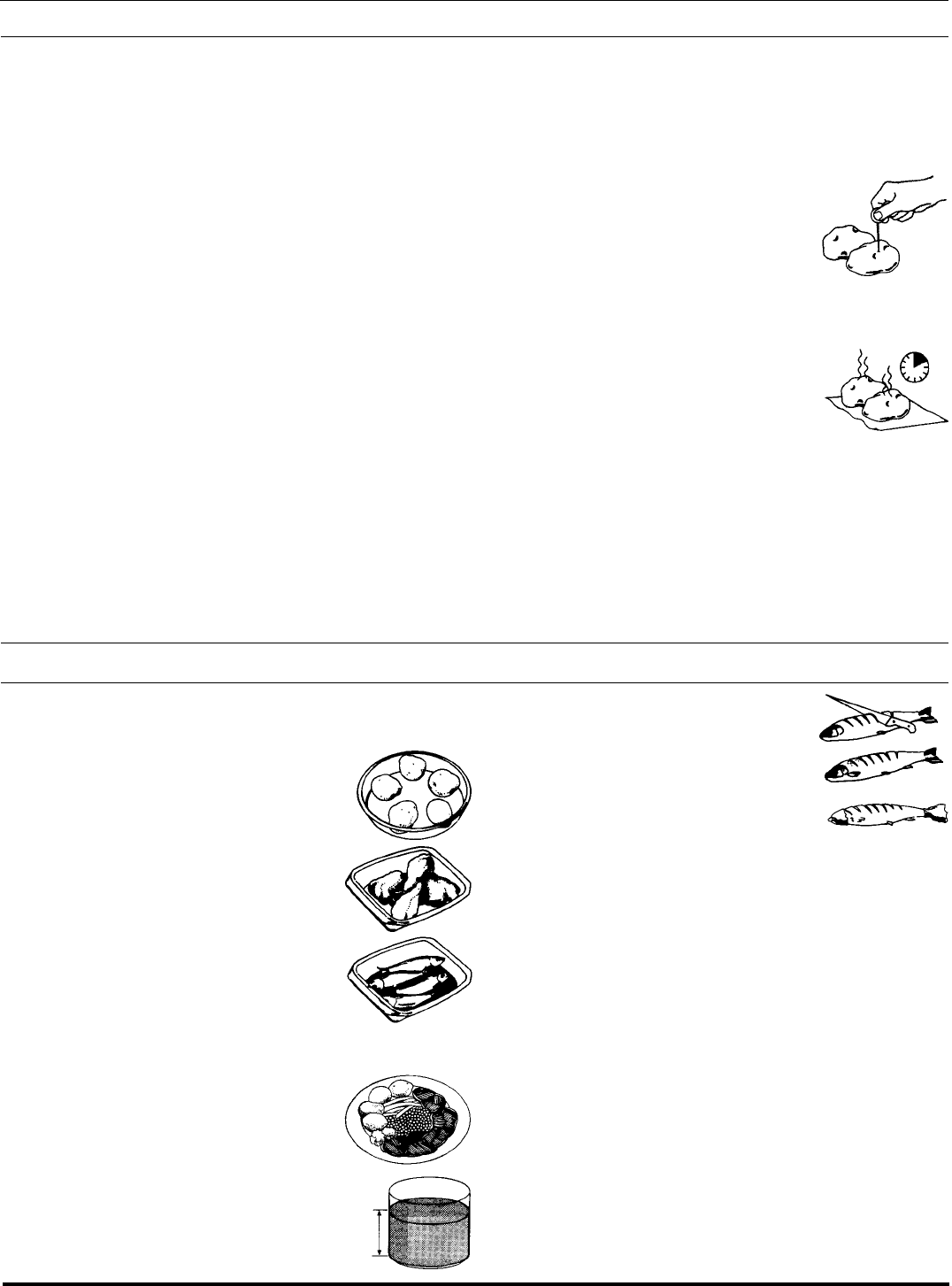
Hints
Points to remember when defrosting manually
* The shape of the package alters the defrosting time. Shallow
rectangular packets defrost more quickly than a deep block.
* Separate pieces as they begin to defrost; free-flow slices
defrost more easily.
* Shield areas of food with small pieces of foil if they start to
become warm. Wooden toothpicks may be used to hold the
foil in place.
* When defrosting, it is better to under-thaw the food slightly
and allow the process to finish during the standing time.
The amount of food
The more food you want to prepare the longer it takes. A rule of
thumb is that double amount of food requires almost double
the time. If one potato takes four minutes to cook,
approximately seven minutes are required to cook two
potatoes.
Moisture content:
Because microwaves are attracted to moisture, cooking time
will vary according to water content. Naturally moist foods such
as vegetables, fish and poultry will cook quickly and evenly;
drier foods such as rice or dried beans require added moisture
for microwave cooking.
Condensation:
Humidity and moisture in foods will sometimes cause
condensation on the walls of the oven or inside the door. This
is normal with cooking. Generally, covered foods will cause
less condensation than uncovered foods.
Sugar:
When cooking foods with a high sugar or fat content, such as
Christmas pudding, mince pies and fruit cake follow the
recommended cooking instructions carefully. Exceeding the
recommended cooking times may result in burning of the food
and damage to the oven.
Releasing pressure in foods
Several foods are tightly covered by a skin or
membrane. These foods should be pricked
with a fork or cocktail stick to relieve the
pressure and to prevent bursting, as steam
builds-up within them during cooking. This
applies to jacket potatoes, potatoes, chicken livers, sausages,
egg yolks and some fruits.
Standing time
Always allow the food to stand for some time after
using the oven. Standing time after defrosting,
cooking/reheating always improves the
result since the temperature will then be
evenly distributed through out the food.
In a microwave oven foods continue to cook even when the
microwave energy is turned off. They are no longer cooked by
microwaves, but they are still being cooked by the conduction
of the high residual heat to the centre of the food. The length of
the standing time depends on the volume and density of the
food. Sometimes it can be as short as the time it takes you to
remove the food from the oven and take it to the serving table.
However, with larger, denser foods, the standing time may be
as long as 10 minutes. The food will finish cooking during this
time.
Arranging Food
The best results are achieved if the food is evenly distributed
on the plate. This is done in several ways in microwave
cooking to give more even cooking results.
If you are cooking several items of the same
food such as jacket potatoes, place them in a
ring pattern for uniform cooking.
When cooking foods of uneven shapes or
thickness, place the smaller or thinner area
of the food towards the centre of the dish
where it will be heated last.
Uneven foods such as fish should be
arranged in the oven with the tails to the
centre.
If you are saving a meal in the refrigerator or
“plating” a meal for reheating, arrange the thicker,
denser foods to the outside of the plate and the
thinner or less dense foods in the middle.
Place thin slices of meat on top of each
other or interlace them.
Thicker slices such as meat loaf and
sausages have to be placed close to each
other.
Gravy or sauce should be reheated in a
separate container.
Choose a tall, narrow container rather than a low
and wide container. When reheating gravy, sauce
or soup, do not fill the container more than 2/3
When you cook or reheat whole fish, score
the skin - this prevents cracking.
Shield the tail and head with small pieces of
foil to prevent over-cooking but ensure the foil
does not touch the sides of the oven.
Composition of the food
Food with a lot of fat and sugar will be heated faster than food
containing a lot of water. Fat and sugar will also reach a higher
temperature than water in the cooking process.
The more dense the food, the longer it takes to heat. “Very
dense” food like meat takes longer time to reheat than lighter,
more porous food like bread.
Size and shape
Smaller pieces of food will cook faster than larger pieces and
uniform pieces of food cook more evenly than irregularly
shaped foods. To ensure even cooking, cut all pieces of food
into similar sizes and shapes.
Stirring, turning of foods during cooking
Stirring and turning of foods are techniques used in
conventional as well as in microwave cooking to distribute the
heat quickly to the centre of the dish and avoids over-cooking
at the outer edges of the food. turning foods is especially
important here because it allows for more even cooking. As in
conventional cooking, foods such as roasts need to be elevated
so they are not allowed to steam in their own juices.
11


















